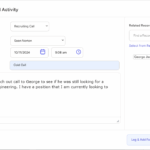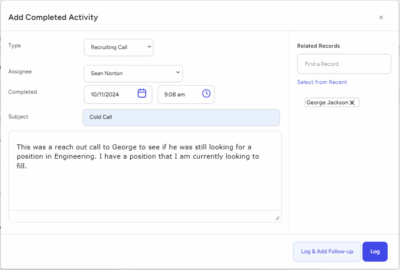Managing a hiring database effectively is crucial for recruiters to stay organized, streamline their processes, and make informed hiring decisions. A well-managed database enables recruiters to efficiently track candidates, maintain clear communication, and build a strong talent pipeline.
Are you struggling to keep your hiring database in order? Then you’ll be glad to know that in this blog post, we’ll be sharing top tips for helping you effectively manage your hiring database and optimize your recruitment workflow.
As you implement these tips, it’s important to choose the right software to support your hiring database management needs. We invite you to request a live demo of Top Echelon Software, a leading provider of comprehensive recruitment solutions. Our software offers robust features, including advanced search capabilities, customizable candidate profiles, centralized communication, and much more.
10 Tips to Manage Your Hiring Database
As we mentioned earlier, managing a hiring database efficiently is critical for recruiters for a number of reasons. These reasons include streamlining the recruitment process, effectively track candidates, and make informed hiring decisions. (That last one might be the most important one.)
With this in mind, below are 10 of the top tips for managing your hiring database:
#1—Standardize data entry and formatting.
When multiple recruiters or team members are involved in adding candidate information, maintaining consistency in data entry ensures accurate and organized records. Listed below are four reasons why standardizing data entry and formatting is important.
Consistency: Standardized data entry ensures that each candidate profile contains the same essential information, such as contact details, work history, education, and skills. This consistency allows for easier searching, filtering, and comparing candidates based on specific criteria.
Improved searchability: By following a consistent format, recruiters can easily search for candidates based on specific fields or keywords. A standardized database ensures that search queries yield accurate and relevant results, saving time and effort in the recruitment process.
Enhanced data integrity: Standardizing data entry helps maintain data integrity by reducing errors and inconsistencies. With a uniform format, it becomes easier to identify and correct any discrepancies in the database, ensuring that candidate information remains reliable and up-to-date.
Streamlined collaboration: When multiple recruiters or team members work on the hiring database, standardized data entry promotes seamless collaboration. It eliminates confusion, reduces the need for additional communication, and ensures everyone understands the structure and format of candidate profiles.
By implementing standardized data entry and formatting guidelines, you can significantly improve the organization, accuracy, and efficiency of your hiring database. It enables easy searching, maintains data integrity, promotes collaboration, and ultimately enhances the overall effectiveness of your recruitment efforts.
#2—Leverage advanced search functionality.
An advanced search feature allows recruiters to refine their candidate searches based on specific criteria, saving time and effort while maximizing the potential of the database. Listed below are four reasons why you should make use of advanced search functionality.
Precise candidate filtering: With advanced search capabilities, you can narrow down your candidate search by applying multiple filters simultaneously. This enables you to find candidates who meet specific requirements, such as skills, experience, location, education, or certifications. By precisely filtering candidates, you can focus on the most relevant individuals for your job openings.
Efficient time-saving: Advanced search functionality significantly reduces the time required to find suitable candidates. Instead of manually sifting through a large database, you can input specific criteria and instantly retrieve a targeted list of qualified candidates. This efficiency allows recruiters to allocate more time to other critical recruitment tasks.
Customized search queries: Advanced search tools often provide flexible search query options, including Boolean operators, wildcards, and proximity searches. These features enable recruiters to create complex search queries, combining multiple criteria and refining results further. Customized search queries offer greater flexibility and precision in finding the right candidates.
Scalability and future relevance: As your candidate database grows, advanced search functionality becomes even more crucial. It ensures that you can effectively navigate through a vast pool of candidates and locate specific profiles quickly. Additionally, advanced search features evolve with changing recruitment needs, allowing you to adapt and stay relevant as your hiring requirements evolve.
By leveraging the advanced search functionality of your hiring database management system, you can efficiently and effectively locate the most suitable candidates for your job openings. The precise filtering, time-saving capabilities, customization options, and scalability provided by advanced search tools contribute to streamlining your recruitment process and ultimately lead to successful candidate placements.
#3—Regularly update candidate profiles.
Keeping candidate profiles up-to-date ensures that your database contains accurate and relevant information, improving the efficiency of your recruitment efforts. Listed below are four reasons why regular profile updates are important.
Accurate candidate information: Candidates’ qualifications, skills, work experiences, and contact details may change over time. By regularly updating their profiles, you ensure that you have the most accurate and current information available. Outdated information can lead to miscommunication, wasted time, and missed opportunities.
Improved candidate matching: When you update candidate profiles, you can capture new skills, certifications, or achievements they have acquired. This updated information helps you better match candidates with job requirements and increases the chances of successful placements. Staying informed about candidates’ latest qualifications allows you to make more precise and targeted hiring decisions.
Enhanced communication and engagement: Regularly updating candidate profiles demonstrates your commitment to staying informed about their professional growth. It also provides an opportunity to re-engage with candidates who may not have been the right fit for previous roles but could be a match for future positions. This personalized approach improves candidate communication, builds rapport, and increases their engagement with your organization.
Data integrity and database efficiency: Outdated or inaccurate candidate profiles can clutter your hiring database, making it harder to find relevant candidates quickly. By regularly updating profiles, you maintain data integrity, ensuring that your database remains organized, streamlined, and efficient. This saves time and effort in future searches and improves overall database management.
Regularly updating candidate profiles is essential for accurate information, improved candidate matching, enhanced communication, and maintaining a well-organized hiring database. By incorporating this tip into your recruitment process, you can ensure that your candidate data remains up-to-date and reliable, leading to more successful placements and an optimized hiring workflow.
#4—Utilize tags and categories.
Tags and categories provide a systematic and organized way to classify and group candidates based on specific criteria, making it easier to search, filter, and identify suitable candidates. Listed below are four reasons why you should make use of tags and categories.
Efficient candidate segmentation: Tags and categories allow you to segment your candidate database based on relevant criteria such as skills, experience level, industry, or location. This segmentation enables you to quickly filter and identify candidates who meet specific requirements for different job openings. It saves time by narrowing down your candidate pool to those most likely to be a good fit.
Easy retrieval and filtering: By applying relevant tags and categories to candidates, you can easily retrieve specific subsets of candidates from your database. When you need to find candidates with particular skills or qualifications, filtering based on tags or categories helps you locate the desired profiles quickly and efficiently.
Improved candidate organization: Tags and categories help keep your hiring database organized and structured. They provide a logical framework for grouping and organizing candidates, preventing clutter and ensuring a streamlined database management process. This organization enables recruiters to navigate the database with ease and enhances overall efficiency.
Targeted communication and outreach: With tags and categories, you can personalize your communication and outreach efforts. By targeting specific groups of candidates based on tags or categories, you can tailor your messaging to their interests, skills, or preferences. This targeted approach enhances candidate engagement and improves the overall candidate experience.
By utilizing tags and categories in your hiring database, you can efficiently segment, retrieve, and filter candidates, ensuring a well-organized database and saving time in the recruitment process. The ability to quickly identify relevant candidates and personalize communication enhances your ability to find the best talent for your job openings.
#5—Centralize communication.
By consolidating all communication within your hiring database management system, you create a centralized hub for tracking and managing candidate interactions. Listed below are four reasons why centralizing communication is important.
Seamless collaboration: Centralizing communication allows all members of your recruitment team to have access to candidate-related conversations, emails, interview notes, and updates. This promotes seamless collaboration, enabling team members to stay informed and aligned throughout the hiring process. It eliminates the need for multiple email threads or scattered communication channels, ensuring everyone is on the same page.
Enhanced candidate engagement: When communication with candidates is centralized, you can easily refer back to previous conversations and maintain a comprehensive view of each candidate’s journey. This enables personalized and contextual communication, enhancing candidate engagement and improving the candidate experience. Candidates feel valued when recruiters demonstrate a thorough understanding of their interactions and preferences.
Improved efficiency: Searching for past email exchanges or interview notes can be time-consuming and cumbersome. By centralizing communication within your hiring database, you can access all candidate-related information in one place, eliminating the need to dig through multiple platforms or email accounts. This saves time and improves overall efficiency in the recruitment process.
Audit trail and compliance: Centralizing communication creates an audit trail that tracks all candidate-related interactions. This helps with compliance and ensures that you have a record of all communication for legal or regulatory purposes. It also facilitates transparency and accountability within your recruitment processes.
By centralizing communication within your hiring database, you can streamline collaboration, enhance candidate engagement, improve efficiency, and maintain compliance. This centralized approach ensures that all team members have access to the necessary information, enabling effective communication and providing a seamless candidate experience throughout the hiring journey.
#6—Implement a feedback and evaluation system.
Gathering feedback from recruiters, hiring managers, and interviewers helps in assessing candidate suitability, tracking progress, and making data-driven decisions. Listed below are four reasons why implementing a feedback and evaluation system is important.
Comprehensive candidate assessment: A feedback and evaluation system allows you to collect input from multiple stakeholders involved in the hiring process. This comprehensive assessment provides a holistic view of candidates, considering different perspectives and insights. It enables a more accurate evaluation of candidates’ skills, qualifications, and fit for the role.
Data-driven decision making: Feedback and evaluation data serve as a valuable resource for making informed hiring decisions. By analyzing feedback and comparing candidates’ assessments, you can objectively assess their strengths, weaknesses, and potential fit for the organization. This data-driven approach minimizes biases and enhances the quality of your decision-making process.
Performance tracking and improvement: Implementing a feedback and evaluation system allows you to track candidates’ progress throughout the recruitment process. You can identify trends, evaluate the effectiveness of your recruitment strategies, and identify areas for improvement. This continuous feedback loop helps refine your hiring process and optimize future recruitment efforts.
Consistency and standardization: A structured feedback and evaluation system promotes consistency in candidate assessment. By providing clear evaluation criteria and guidelines to stakeholders, you ensure a standardized approach to candidate evaluation. This consistency enhances fairness and reduces subjective biases in the hiring process.
By implementing a feedback and evaluation system, you gather valuable insights, make data-driven decisions, track candidate progress, and improve your hiring process. It helps you assess candidates objectively, ensure consistency in evaluation, and optimize the overall effectiveness of your hiring database management.
#7—Integrate with external tools and platforms.
Integrating your hiring database with external tools and platforms is a valuable tip to effectively manage your recruitment process. Integration allows for seamless data transfer, eliminates duplicate data entry, and enhances overall workflow efficiency. Listed below are five reasons why integrating with external tools and platforms is important.
Streamlined job distribution: Integrating your hiring database with job boards, career sites, and social media platforms enables you to effortlessly distribute job postings. This integration eliminates the need for manual posting on multiple platforms, saving time and ensuring consistency in job advertisements.
Simplified candidate sourcing: Integration with external tools such as sourcing platforms or LinkedIn allows recruiters to easily import and track candidates from different sources. It streamlines the candidate sourcing process, expands the candidate pool, and enhances recruitment reach.
Efficient background checks and assessments: Integration with background check services and assessment platforms facilitates a seamless flow of information. Recruiters can request and receive background check reports or assessment results directly within their hiring database, eliminating the need to switch between multiple systems.
Improved candidate experience: Integrating with external tools and platforms creates a seamless experience for candidates. Candidates can easily apply for positions through career sites or job boards, and their application information is automatically captured in your hiring database. This integration enhances the candidate experience, reduces manual data entry, and eliminates the risk of data loss.
Data consolidation and analysis: Integration enables the consolidation of data from various sources into a single, unified hiring database. This consolidation allows for comprehensive data analysis and reporting. By combining data from different platforms, you gain valuable insights into the effectiveness of your recruitment strategies, source quality, and overall hiring metrics.
By integrating your hiring database with external tools and platforms, you can streamline your recruitment workflow, simplify candidate sourcing, enhance the candidate experience, and gain valuable insights from consolidated data. Integration eliminates manual processes, reduces data entry errors, and optimizes the overall efficiency and effectiveness of your hiring database management.
#8—Maintain data security and compliance.
Protecting candidate information and ensuring compliance with privacy regulations builds trust, safeguards sensitive data, and mitigates risks. Listed below are five reasons why prioritizing data security and compliance is important.
Protecting candidate privacy: Candidate data stored in your hiring database includes sensitive personal information. By implementing robust data security measures, such as access controls, data encryption, and secure server infrastructure, you protect candidates’ privacy and prevent unauthorized access or data breaches.
Complying with privacy regulations: Privacy regulations, such as GDPR (General Data Protection Regulation) or CCPA (California Consumer Privacy Act), impose strict requirements on how candidate data should be handled. Ensuring compliance with these regulations is essential to avoid legal consequences and maintain the trust of candidates.
Building trust and reputation: Demonstrating a commitment to data security and compliance enhances your reputation as a responsible and trustworthy organization. Candidates are more likely to engage with a company that values and protects their personal information. Prioritizing data security and compliance contributes to a positive candidate experience and strengthens your employer brand.
Mitigating risks and liabilities: Data breaches or mishandling of candidate data can result in significant financial and reputational damage. By implementing data security measures and complying with privacy regulations, you mitigate risks and liabilities associated with data breaches, potential lawsuits, and regulatory penalties.
Data retention and disposal: Managing data security and compliance includes establishing protocols for data retention and disposal. Determine the appropriate retention periods for candidate data and establish procedures for securely disposing of data that is no longer necessary, in accordance with legal requirements.
By maintaining data security and compliance, you protect candidate privacy, comply with regulations, build trust, mitigate risks, and safeguard your organization’s reputation. Prioritizing data security and compliance ensures that your hiring database management practices align with industry standards and legal obligations.
#9—Regularly clean and de-duplicate the database.
Over time, databases can accumulate duplicate or outdated entries, which can lead to confusion, inefficiencies, and inaccurate reporting. Listed below are five reasons why regularly cleaning and de-duplicating the database is important.
Data integrity and accuracy: Cleaning and de-duplicating your hiring database ensures data integrity by removing duplicate entries and updating outdated information. This enhances the accuracy and reliability of your candidate data, providing a more accurate representation of your candidate pool.
Improved search efficiency: Duplicate entries can clutter your database and make it challenging to locate and manage candidate profiles efficiently. By eliminating duplicates, you streamline the search process, save time, and improve the overall efficiency of your recruitment efforts.
Enhanced reporting and analysis: A clean and de-duplicated database enables accurate reporting and analysis. You can generate more reliable metrics and insights regarding candidate sources, applicant-to-hire ratios, and other recruitment KPIs. Clean data allows for better decision-making and the ability to identify trends or areas for improvement.
Streamlined communication: Duplicate entries can lead to confusion and errors in communication. By removing duplicates, you can ensure that your communication efforts are targeted, accurate, and efficient. This improves candidate experience and maintains professionalism throughout the hiring process.
Compliance with data protection regulations: Regularly cleaning and de-duplicating your hiring database helps ensure compliance with data protection regulations. By removing unnecessary or duplicate data, you minimize the risk of retaining data beyond legal requirements, reducing potential privacy breaches and associated liabilities.
By regularly cleaning and de-duplicating your hiring database, you maintain data integrity, improve search efficiency, enhance reporting and analysis capabilities, streamline communication, and ensure compliance with data protection regulations. This practice helps you make informed decisions, optimize recruitment processes, and effectively manage your candidate data for successful placements.
#10—Continuously improve and optimize.
Continuously improving and optimizing your hiring database management practices is a valuable tip to ensure its effectiveness and efficiency over time. By embracing a culture of continuous improvement, you can stay ahead of the curve, adapt to changing needs, and enhance your recruitment efforts. Listed below are five reasons why continuously improving and optimizing is important.
Evolving technology: The recruitment landscape is constantly evolving, and new technologies emerge regularly. By continuously improving and optimizing your database management practices, you can leverage advancements in technology to streamline processes, enhance functionalities, and stay competitive in attracting top talent.
Refining workflows: Through regular evaluation and feedback, you can identify bottlenecks, inefficiencies, and areas for improvement within your hiring database management processes. By analyzing and refining your workflows, you can streamline operations, reduce redundant tasks, and enhance overall efficiency.
Data-driven decision making: Continuously optimizing your hiring database management practices enables you to collect and analyze data, allowing for data-driven decision-making. By tracking recruitment metrics, identifying trends, and analyzing performance, you can make informed decisions to improve candidate sourcing, selection, and placement strategies.
Keeping up with best practices: By continuously improving and optimizing your database management, you stay informed about industry best practices. This helps you adopt new approaches, implement proven methodologies, and align your practices with the evolving standards and expectations of the recruitment industry.
Enhanced candidate experience: A well-optimized hiring database management process contributes to an improved candidate experience. Streamlined workflows, personalized communication, and efficient processes create a positive impression, increasing candidate satisfaction and engagement with your organization.
By continuously improving and optimizing your database management practices, you ensure that your recruitment efforts remain efficient, effective, and adaptable. It allows you to harness the benefits of evolving technologies, refine workflows, make data-driven decisions, keep up with best practices, and enhance the candidate experience. Continual optimization positions you to stay ahead in the competitive job market and achieve successful outcomes in your recruitment endeavors.
Once again, effectively managing your hiring database is essential for recruiters to streamline their recruitment processes and make informed hiring decisions. And when you make informed decisions, you make better decisions. And don’t miss out on the opportunity to optimize your recruiting database management.
Request a live demo of Top Echelon Software today and discover how our solution can streamline your recruitment process. Contact us now to schedule your personalized demonstration and take a step towards efficient and effective hiring!









